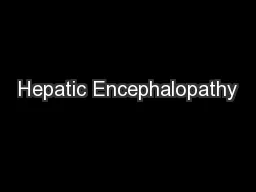

By Michelle Russell Case Study Presentation NUR 4216L 12412 1 Objectives Understand the pathophysiology of hepatic encephalopathy Recogonize the signs symptoms Understand relevance to clinical setting and patient scenarios ID: 476224
Download Presentation The PPT/PDF document "Hepatic Encephalopathy" is the property of its rightful owner. Permission is granted to download and print the materials on this web site for personal, non-commercial use only, and to display it on your personal computer provided you do not modify the materials and that you retain all copyright notices contained in the materials. By downloading content from our website, you accept the terms of this agreement.
Slide1
Hepatic Encephalopathy
By: Michelle RussellCase Study PresentationNUR 4216L12-4-12
1Slide2
Objectives
Understand the pathophysiology of hepatic encephalopathyRecogonize the signs/ symptoms
Understand relevance to clinical setting and patient scenarios
2Slide3
What is it?
Hepatic Encephalopathy is a brain disorder that can occur when the liver is unable to remove toxins from the bloodCan be acute or chronic; and range from mild to severe; may progress slowly or rapid
Can be a medical emergency, patients usually hospitalized
3Slide4
Causes
Caused by disorders that affect the liver:Commonly hepatitis or cirrhosis
Disorders that cause blood circulation to decrease to the liver
4Slide5
Symptoms
Mild
Severe
Breath with a musty or sweet odor
Change in sleep patterns
Changes in thinking
Confusion that is mild
Forgetfulness
Mental fogginess
Personality or mood changes
Poor concentration
Poor judgment
Worsening of handwriting or loss of other small hand movements
Abnormal movements or shaking of hands or arms
Agitation, excitement, or seizures (occur rarely)
Disorientation
Drowsiness or confusionInappropriate behavior or severe personality changesSlurred speechSlowed or sluggish movement
5Slide6
Complications
Brain swellingPermanent nervous system damageIncreased risk of heart failure, kidney failure, respiratory failure and sepsis (blood poisoning) unconscious, unresponsive or coma
Death
6Slide7
Diseases that masks symptoms
Alcohol intoxicationComplicated alcohol withdrawalMeningitisMetabolic abnormalities such as low blood glucose
Sedative overdose
Subdural hematoma
Wernicke-Korsakoff
syndrome
7Slide8
Objective findings/ diagnostics
Asterixis “liver flap”Ask patient to hold their hands out in front of them, it will jerk
http://www.youtube.com/watch?v=1yFRzxbJnqQ
Neuro examination
CT scan or MRI of head
EEG
Liver function tests
Serum ammonia levels
PT/INR
Potassium/ sodium levels
8Slide9
Stages
Grade 0 - Minimal hepatic encephalopathy, asterixis not present; mild cognitive impairment
Grade 1
- Trivial lack of awareness.
Asterixis
can be detected.
Grade 2
- Lethargy or apathy. Disorientation. Obvious
asterixis
.
Grade 3
- Somnolent but can be aroused
Grade 4
- Coma with or without response to painful stimuli
9Slide10
Treatment
Life support if in comaElectrolyte/ fluid balanceReduce protein level to lower ammonia level- possible long term diet change
Lactulose- prevent intestinal bacteria from creating ammonia
10Slide11
Prognosis
Can be treatableChronic typically gets worse, or comes backIf patient is put into a coma, 8 out of 10 patients die
11Slide12
Nursing Diagnosis
Altered level of consciousnessImpaired nutritionFluid/ electrolyte imbalance
12Slide13
ARTICLE 1: Hepatic encephalopathy in liver cirrhosis
InterventionsTemporarily decrease protein intake and increase
carb
intake
Intestinal cleaning
to remove nitrogen containing sources as a possible source of ammonia
Lactulose
Antibacterials
– influence ammonia flora, therefore decrease ammonia level
Antipsychotics
- theory (still inconclusive) that certain drugs preventing the binding of GABA decrease HE
13Slide14
ARTICLE 2: Hepatic Encephalopathy in End-Stage Liver Disease
InterventionsDiagnosis of exclusion
Correct underlying cause (if applicable)
Lactulose (should be titrated to 3-4 loose stools daily, about 30-60g)
Supports bacterial growth…
Antibiotics such as neomycin – lower ammonia levels in gut
Establish healthcare proxy
Education – recognize S/S, when to notify provider
prevent falls, skin breakdown, aspiration
14Slide15
NCLEX style review questions
15Slide16
Question #1
A client is admitted with an elevated serum ammonia level and iron-deficiency anemia. The nurse knows this client has some degree of liver failure because: A. The liver is the storage center for iron
B. The client is in acute renal failure and liver failure follows
C. The liver converts ammonia to the harmless substance of urea
D. Both A and C are correct
16Slide17
D is correct
D. Both A and C are correct
The liver is the major storage center for iron. The liver is responsible for converting ammonia into urea for excretion by the kidneys.
17Slide18
Question #2
A client is admitted with an alteration in neurological status and is in the process of being diagnosed with hepatic encephalopathy. Which of the following is known about this diagnosis?
A. It is caused by a build up of urea
B. It is caused by the build up of ammonia and protein metabolism malfunction
C. reduced cardiac output is the leading cause of death in these clients
D. It is caused by carbohydrate metabolism dysfunction
18Slide19
B is correct
B. It is caused by the build up of ammonia and protein metabolism malfunction
This is the hallmark symptom of acute hepatic failure. Also termed hepatic coma, this is caused by a buildup of ammonia. Cerebral edema is the leading cause of death in this condition.
19Slide20
Question #3
A client with acute hepatitis is prescribed lactulose. The nurse knows this medication will:A. Mobilize iron stores from the liver.B. Remove
bilirubin
from the blood.
C. Prevent the absorption of ammonia from the bowel
D.
Prevent hypoglycemia.
20Slide21
C is correct
C. Prevent the absorption of ammonia from the bowel
Lactulose helps prevent the absorption of ammonia from the bowel because it will cause frequent bowel movements, which facilitates the removal of ammonia from the intestines.
21Slide22
Conclusion
Exact cause of HE is unknownIt is still inconclusive about ‘correct’ interventionsRecognize S/S and risk factors in patients
Change in LOC
Suspected in liver failure patients
22Slide23
References
American liver foundation. (2012, July 17). Retrieved from http://www.liverfoundation.org/abouttheliver/in fo
/
hepaticencephalopathy
/
Gerber, T., &
Schomerus
, H. (
n.d
.). Hepatic encephalopathy in liver cirrhosis.
Disease Management
, 1353-1367
Longstreth
, G. (2011, October 16).
Medline plus
. Retrieved from http://www.nlm.nih.gov/medlineplus/en cy/article/000302.htmWilson Childers, J., & Arnold, R. M. (2008). Hepatic encephalopathy in end-stage liver disease.
Fast Facts and Concepts, 1341-1342Wolf, D. (2011, March 9). Medscape. Retrieved from http://emedicine.medscape.com/article/186101- overview23Slide24
Thank you!
Questions???
24